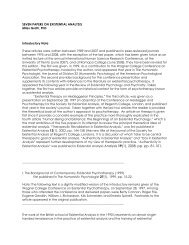The Sonate auf Concertenart: A Postmodern Invention? David ...
The Sonate auf Concertenart: A Postmodern Invention? David ...
The Sonate auf Concertenart: A Postmodern Invention? David ...
You also want an ePaper? Increase the reach of your titles
YUMPU automatically turns print PDFs into web optimized ePapers that Google loves.
5<br />
See his discussion of fugue (Bach and the Patterns of <strong>Invention</strong>, 135).<br />
<strong>Sonate</strong> <strong>auf</strong> <strong>Concertenart</strong>, p. 5<br />
5<br />
has criticized the reflexive application of the "metaphor of 'genre as form,'" leading one to ask<br />
how useful it is to understand the works in question as alluding to idealized musical genres chiefly<br />
through what we perceive as their formal procedures.<br />
<strong>The</strong> evidence admits a different interpretation: that the sonata and the concerto were not<br />
clearly distinct genres during the first decade or two of the eighteenth century, when Bach,<br />
Telemann, and their contemporaries were beginning to compose their works for instrumental<br />
ensemble. Rather, the two terms, if not exactly synonymous, at first bore only slightly differing<br />
connotations, emerging as labels for truly distinct genres during the course of these composers'<br />
careers, after each had already written a substantial portion of his output under both titles<br />
"sonata" and "concerto." Modern writers, employing a mode of discourse common in latetwentieth-century<br />
academic prose, habitually speak of eighteenth-century instrumental<br />
compositions as alluding to or referring to other works or genres. But whether, and how, a nonverbal<br />
composition can "refer" to another one is a nice philosophical problem; at what point, if<br />
any, does the presence of common stylistic or structural features achieve the indexical function of<br />
explicitly pointing to another work or type? <strong>The</strong> argument becomes especially problematical when<br />
the perceived resemblances are not rigorously analyzed or are described through modern concepts<br />
such as "ritornello form," whose precise meaning or applicability to the works cannot be taken for<br />
granted. Far from having been intended to blend or allude to disparate genres, it may be that the<br />
works in question simply happened to employ varieties of form, scoring, and other musical<br />
elements that would later become identified with the genres with which we now associate them.<br />
As is well known, both sonatas and concertos had existed from the beginning of the<br />
seventeenth century. But only during the last decades of the seventeenth century does the term<br />
concerto seem to have been first applied to purely instrumental works. Torelli published his opus<br />
6 Concerti (Augsburg, 1698) while he was at Ansbach, where his pupils included the young<br />
Pisendel--so by 1700 concerto was certainly familiar to some Germans as a title for an<br />
instrumental composition. But these and other early concertos show few of the features that we<br />
associate with the term, and for German musicians and their audiences the instrumental concerto<br />
cannot have become distinct from the sonata along the lines now understood until the second<br />
decade of the eighteenth century. Even in the 1720s and later, the terms sonata and concerto were<br />
still sometimes applied in ways that are now hard to understand, although the expression concerto<br />
was becoming limited to works that employed what copyists and writers of the period called<br />
6<br />
concertato parts. To borrow a phrase from Alexander Silbiger, the sonata and concerto for a<br />
while may have formed a genre pair, like the chaconne and passacaglia. But whereas the evolution<br />
of the latter pair converged, the sonata and concerto were in the process of diverging during the<br />
6<br />
Although in current usage the term concertato (and its English equivalent "concerted") is<br />
often applied to genres, one rarely discovers such a thing as a "concerted fugue" in<br />
eighteenth-century titles; rather, one finds concerted violin or harpsichord parts--that is, obbligato<br />
or solo parts. It is, then, anachronistic to use the adjective "concerted" to mean "in the style of a<br />
concerto."















